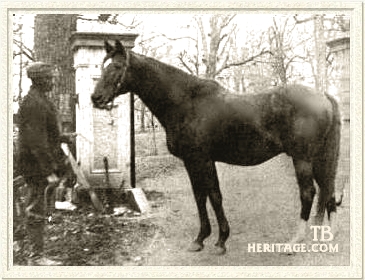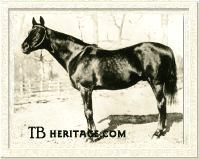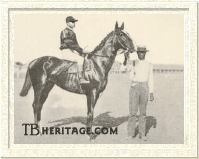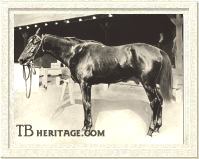|
|
Spendthrift

|
|
 |
|
|
The male line of the Godolphin Arabian has seemingly held on by a thread for over 150 years, yet the line keeps coming up with one individual of superior quality which keeps it from falling into extinction. Such an individual was Spendthrift.
Spendthrift's sire was English-bred Australian, by West Australian, England's first Triple Crown winner. Australian was purchased as a foal by A. Keene Richards, master of Blue Grass Park near Georgetown, Kentucky, with Richard Ten Broeck acting as agent. Sent across the Atlantic with his dam, the Young Emilius mare Emilia, he became a decent, though unspectacular racehorse, winning several races under the name Millington before his sale to Robert A. Alexander late in 1861. Re-named Australian, he raced only once for his new owner, as a four-year-old, before retiring to stud at Alexander's Woodburn Farm near Midway, Kentucky. Australian shared the stallion accommodations with Lexington, the premier sire in the country. Despite being overshadowed by his more celebrated studmate, Australian managed to carve out a niche for himself as a top stallion. During his stud career, he came up with the likes of American classic winners Baden-Baden, Springbok, and Joe Daniels, and Maggie B.B., one of the most important producers of her day.
Naturally, the choicest mares were reserved for Lexington's book, but Australian received his share of good ones. He was bred several times to Aerolite, a daughter of Lexington who was an unraced full sister to the champion mare Idlewild. Aerolite achieved stellar results from her unions with Australian, producing Fellowcraft, who was renowned for breaking Lexington's record for four miles; Rutherford, and Mozart, the latter a blind horse who won several races, and Spendthrift, who was born in 1876.
Spendthrift's breeder was A.J. Alexander, who had inherited Woodburn Farm upon the death of his brother Robert in 1867. As a yearling, Spendthrift was acquired by Daniel Swigert, master of Elmendorf Farm near Lexington. Swigert named the colt to memorialize his wife's spending habits, which encompassed extravagent shopping sprees in New York. A year later, Mrs Swigert selected the name for Spendthrift's younger brother, Miser.
Spendthrift on the Turf
Spendthrift began his racing career as a member of the Swigert stable. As a two-year-old, Spendthrift raced on the Kentucky--Tennessee circuit, where the competition was really no match for him. He was an outstanding individual. Walter S. Vosburgh summarized his attributes:
"Spendthrift was a chestnut, with a diamond-shaped star, and both hind pasterns white. He had a beautiful, clean-cut head, deep neck, short back, and his shoulders were a trifle heavy. He also had very thin-soled feet, and hard ground gave him trouble. He was a fine-tempered horse and easy to ride."
Spendthrift made his debut at Lexington on September 13, 1878. The track was muddy, which did not to bother him. With his delicate feet, wet going was a blessing. He won easily by four lengths. Next out, at Louisville, Spendthrift had a harder race to capture the Sandford Stakes. He won his third race by three lengths, the proceeds going to a fund for those plagued with yellow fever. Shipped to Nashville, Tennessee, Swigert's colt emerged victorious in the Young America Stakes No. 1. Behind him was the future Kentucky Derby winner Lord Murphy, a son of the Lexington stallion Pat Malloy. Spendthrift defeated Lord Murphy again in his last start of the season, a mile race at Nashville. Spendthrift was unbeaten as a two-year-old, and what was more, his campaign had attracted the attention of horsemen in the east.
The stables of the brothers Pierre and George Lorillard were the pre-eminent ones in the east. George Lorillard's Harold, a chestnut son of Leamington and Maggie B.B. was the nation's champion two-year-old and was fully expected to reign supreme the next season. James Gordon offered Daniel Swigert $10,000 for Spendthrift, with the goal of bringing the colt east. The offer was turned down. Then New York financier James R. Keene offered $15,000 for Spendthrift, and that offer was accepted. Spendthrift went east, becoming the first top class horse to carry the white with blue dots of James R. Keene. Spendthrift was sent to be trained by Col. Thomas Puryear, who broke his horses at Valley Brook Farm near Rutherford, New Jersey.
The first target Spendthrift was sent after was the important one mile Withers Stakes. In the field was Harold, as well as Spendthrift's stablemate Dan Sparling. Spendthrift finished second to Dan Sparling, the race more notable as the event which led to the ruin of Harold, that colt suffering a ruptured blood vessel during the running of the race which affected him throughout the rest of his career. Only five days after the Withers, Spendthrift easily captured the Belmont Stakes, again defeating Harold. In the Lorillard Stakes, run over 1-3/8 miles, Spendthrift was kicked at the post by either Magnetism or Harold, versions vary, and was left at the start. Despite this, Spendthrift galloped on relentlessly and caught up to the leaders, Harold among them. The latter seemed bound for victory, but could not withstand the drive of Keene's colt, losing to Spendthrift by a length. Spendthrift next picked up a victory in the Jersey Derby. Thus far, Spendthrift seemed to be the best three-year-old colt in training, not just in the east, but in the country.
Spendthrift ran into a buzz saw in his next two races in the form of Falsetto. Though he had been beaten in the Kentucky Derby by Lord Murphy, Falsetto was a top notch performer. The two met in the Travers Stakes at Saratoga. Granted Spendthrift's feet had begun to bother him, and this may have compromised his form. Yet nothing could be taken away from Falsetto, as he defeated Spendthrift by two lengths in the Travers, with Harold, Jericho, and Dan Sparling among the beaten. The result was much the same in the Kenner Stakes at Saratoga. Falsetto won over Spendthrift by two lengths, with Jericho, Monitor, and Harold strung out behind. Spendthrift closed out his three-year-old season by again defeating Harold and the older Bramble in the Champion Stakes at Monmouth Park and then losing a race at Jerome Park. By the end of the season, Spendthrift's feet were so sore, he was stopped and put under veterinary care. Spendthirft was named co-champion three-year-old male, along with Falsetto, for 1879.
The following season, Spendthrift was shipped to England, along with Keene's colt Foxhall. While Foxhall made the voyage worthwhile by winning the Ascot Gold Cup, Spendthrift fell ill, and in his only race in England, ran unplaced in the Cambridgeshire Handicap. Returned to the United States, Spendthrift made two starts as a five-year-old in 1881 and lost both times. He was retired with a record of nine wins in sixteen starts and $27,250 in earnings.
Spendthrift in the Stud
At the time of Spendthrift's retirement, Keene had no stud of his own in which to stand stallions--the advent of Castleton was still more than a decade away. So Spendthrift was sent to the farm of William Kenney near Lexington, standing there until Keene was forced to sell him and many of his other assets in 1884 after an abortive attempt to corner the wheat market led to his financial defeat by fellow financier and personal enemy Jay Gould. Spendthrift spent some time at Dr. E.M. Norwood's farm near Lexington, and then was purchased, along with 31 mares, by the partnership of Senator Johnson N. Camden and Overton and Christopher Chenault. Spendthrift was then moved to Camden's Hartland Stud on the road outside Versailles. The partnership, which was known as Spendthrift Stud, was dissolved in 1892. Overton Chenault then bought Spendthrift for $13,500. The stallion lived out the remainder of his life at Chenault's farm on Winchester Pike outside Lexington.
No matter where Spendthrift stood, he was a fine stallion. In his first crop came KINGSTON, foaled on April 4, 1884. |

Kingston
| |
Kingston was a brown colt produced from the imported English mare Kapanga, a daughter of Victorious and the Stockwell mare Kapunda. Kapanga had been purchased in England when Keene had sent Spendthrift and Foxhall there, and came to America with her future mate on the return voyage. Keene bred Kingston, but the colt and his dam were among the horses sold after his financial crash. The colt went for $2200 to E.V. Snedeker and J.F. Cushman, for whom he raced as a juvenile, winning two of six starts. Kingston was purchased by Mike and Phil Dwyer as a three-year-old. He remained in training through the age of ten, winning 89 of 138 starts, the most victories of any racehorse on record.
|
Early in his career, Kingston faced stars of the Dwyer stable in Tremont and Hanover. Though he was beaten by them, the Dwyers nonetheless purchased him for $12,500 with the intention of keeping him out of the way. What they got for their money was a horse of extraordinary toughness and quality. He took on and beat some of the best performers of the day besides Tremont and Hanover, including the champion mare Firenze and Domino's full sister Correction. From August 21st of Kingston's four-year-old year until May 30th of his seven-year-old year, Kingston lost only twice in 35 races, his losses coming as second place finishes to Hanover and the tough mare Los Angeles. During his career, Kingston captured thirty stakes, and earned $140,195.
By the time Kingston was finally retired after the 1894 racing season, James R. Keene had recouped his fortune and set about buying horses again. He re-acquired Kingston and installed him at his new Castleton Farm near Lexington. Kingston led the American sire list twice, in 1900 and 1910. His Ballyhoo Bey captured the 1900 Futurity Stakes for William Collins Whitney and led Kingston's earners that year, and Novelty, also a champion juvenile, took not only the Futurity, but the Hopeful and Saratoga Special in 1910. Novelty during his career also raced in Canada, France, and Brazil, over hurdles as well as the flat. He went to stud in Brazil, where he became a very successful sire and sire of broodmares. Other top winners by Kingston included champion filly Admiration, Belmont Stakes winner Ildrim, and King's Courier, winner of stakes in the US at two and winner of the Doncaster Cup and Jockey Club Stakes in England. Kingston died at Castleton in 1912, aged 28.
BANKRUPT, out of the Favonius mare Authoress, was as tough and durable campaigner as Kingston. Unlike Kingston, Bankrupt was a gelding. He was kept in training for twelve seasons, during which time he won 86 races. |

Lamplighter
| |
LAMPLIGHTER, a brown colt with a blaze and three white feet, was foaled in 1889 and produced from the imported mare Torchlight, a daughter of Speculum. Lamplighter was bred by the Spendthrift Stud partnership, and sold as a yearling to a Captain Brown, in whose colors he won six times as a two-year-old. Lamplighter was not nominated to any of the classics for three-year-olds, but still won nine races, including the Champion Stakes and First and Second Special Stakes.
|
He was then bought by Pierre Lorillard, for whom he raced as a four-year-old. He won nine out of eighteen races, but was considered something of a disappointment, for Lorillard was confident he had a colt capable of winning the premier handicap races of the season. However, Lamplighter finished second in the Brooklyn Handicap after getting into considerable trouble during the running and finished third to Lowlander in the Suburban Handicap.
Lamplighter was a temperamental racetrack performer, prone to bumping other horses or getting boxed in, and these antics cost him dearly, as was evidenced in the Brooklyn. Eventually, the colt became a sulker and would quit during the running of races. However, he did win over $89,000. Lorillard sold him, and Lamplighter was retired to stud, where he stood at Milton Young's McGrathiana Stud. His best progeny included Arsenal, winner of the 1902 Metropolitan Handicap, Holscher; winner of the Brighton Cup; and James Reddick, third to Sir Huon in the 1906 Kentucky Derby. Lamplighter was fourth in the sire's list in 1902, and second to Ben Strome in 1903.
STOWAWAY, foaled in 1890 was a winner of the Kenner Stakes at Saratoga. Spendthrift had several top class performers in his 1891 crop. ASSIGNEE, out of Maid of Athol, by Clanronald, was owned by James R. Keene. He was a winner of the Preakness Stakes and ran third to Henry of Navarre in the Belmont Stakes. SELIKA, was a filly out of Messmate by Alarm. She won the Kentucky Oaks. LAZZARONE was a beautifully bred individual, his dam being the champion mare Spinaway, by Leamington. He was victorious in the 1895 Suburban Handicap. Lazzarone was not a successful stallion, though his daughter Sweet Hawthorne did become the dam of Colonel Holloway, winner of the 1912 Preakness Stakes.
In 1893, Spendthrift was the sire of two outstanding runners. The first of these was the filly LADY INEZ, the result of his union with the Longfellow mare Longitude, during her racing days a victress in the Kentucky Oaks. Lady Inez captured the Tennessee Oaks and ran a strong second to males in the Arkansas Derby. The second high class horse from this crop was the colt HASTINGS. |

Hastings
| |
Hastings was a brown colt, bred by Dr. J.D. Neet at his farm near Versailles, Kentucky. The dam of Hastings was a small, unattractive mare named Cinderella. Her unattractiveness was more than skin deep, for she was a particularly ill-tempered individual. Her parentage was suspect, her sire given as Blue Ruin or Tomahawk, "with Tomahawk preferred." Her procreative abilities were not in question, for after Hastings she became the dam of Kentucky Derby winner Plaudit. Hastings was sold at auction as a yearling to the partners David Gideon and John Daly for $2800.
|
He won his first three races at two in brilliant fashion. The partners decided to disperse their bloodstock during that same season, and Hastings was sold at auction to Major August Belmont for the incredible price of $37,000. Belmont aimed to win the Futurity with Hastings. The colt fell ill at Saratoga, and though recovered enough to run in the Futurity at Sheepshead Bay that fall, could only finish fifth to former stablemate Requital, who had been kept by Gideon.
Hastings at three was one of the best three-year-olds in training. He began the season narrowly losing the Withers by only a head to the highly regarded Handspring, winning the Toboggan Handicap against older horses, and defeating Handspring in a hard fought stretch run in the Belmont Stakes. Kept in training as a four-year-old, Hastings was not quite as effective, winning only four of twelve starts. He had inherited the evil temper of his dam and he came to resent training. He was retired to Belmont's Nursery Stud near Lexington. The premier stallion there was Henry of Navarre, who got the choice mares. Nevertheless, Hastings led the general sire list in 1902 and 1904. He was the sire of several top class individuals, but his lasting fame rests with his son Fair Play, a high class racetrack performer and sire of Man O' War. Hastings died at the age of 24, on June 17, 1917.
Spendthrift got several daughters who produced important winners. EXCELLENT, out of Excellenza, by Excel, became the dam of Adoration, an Ornament filly which captured the Matron Stakes and Clover Stakes at two in 1906 and the Sayville Stakes the next season. GRENADINE, out of Bombazine, by Uncas, produced Broadcloth to the cover of Woolsthorpe. Broadcloth, foaled in 1902, was a winner of the Manhattan, Adirondack, and Plymouth Handicaps. KATY OF THE WEST, out of Perdita, by Prince Charlie, was the dam of Hermis, a Hermence colt foaled in 1899. During his career, Hermis won the Travers Stakes, Saranac Handicap, Jerome Handicap, Ocean View Handicap, Merchants and Citizens Handicap, Brighton Cup, and the Suburban Handicap. Hermis was acknowledged Horse of the Year in 1902 and 1903, champion three-year-old male in 1903, and champion handicap horse in 1903 and 1904. PURITAN LASS, out of Phoebe Mayflower, by Phaeton, produced Tillo, a colt by Leonatus in 1894. Tillo won the Suburban Handicap in 1898. SPARK, a full sister to Lamplighter, became dam of Lyddite, a classic winner in Canada, when she captured the King's Plate and Breeders' Stakes. Lyddite in turn became the dam of Canadian classic winners Amberite and Shimonese, both by Martimas. The former was a winner of the Breeders' Stakes, the latter was a winner of the King's Plate.
Other daughters of Spendthrift who were significant included: TOUCHE PAS, out of My Nannie O, by The Palmer. She became the second dam of Rubio, the American-bred winner of the 1908 Grand National; ALARM BELLE, out of The Niece, by Alarm, became the second dam of the good handicapper Blazes, conqueror at one time or another of Exterminator, Sir Barton, and John P. Grier; CHARITY, out of Kalula, by King Alfonso, became the second dam of Helen Barbee, champion American older mare of 1912; MINERAL, out of imported Potash, by Lord Clifden, became the second dam of Hazelwood, foaled in 1901 and a winner of the Youthful Stakes; QUEENSTON, a younger full sister to Kingston, was the third dam of Pillory, winner in 1922 of the Preakness and Belmont Stakes. The blood of Spendthrift wound its way into the pedigrees of American Quarter Horses via his daughter ISBELL. Foaled in 1887 from the imported Blinkhoolie mare Gadabout, Isbell became the third dam of Joe Blair, registered as a Thoroughbred, but a major sire in Quarter Horse pedigrees, his grandson Joe Reed II was a champion Quarter Horse racer and sire and was elected to the American Quarter Horse Hall of Fame.
Spendthrift lived to the age of 24. He died suddenly from the complications of old age, at Overton Chenault's Spendthrift Stud on the Winchester Pike on October 21, 1900. Though the stallion had been in delicate health and was not expected to live through the upcoming winter, the suddenness of his demise came as a surprise to those connected with him, though relief was expressed in his Thoroughbred Record obituary that the old horse went peacefully and did not linger when his health was in obvious decline. Spendthrift's former owner, Senator Camden, recalled the old stallion fondly, "His disposition was superb. I never owned, and never expect to own, a horse with a sweeter disposition. He displayed nothing of the traits which afterward appeared in Hastings and were later transmitted by him in lesser degree to some of his sons and daughters." At the time of Spendthrift's death, the oldest foals of his son, the fiery Hastings, were just yearlings, and they represented the promise that Spendthrift's heritage would continue.
--Liz Martiniak
|
|
|
|

